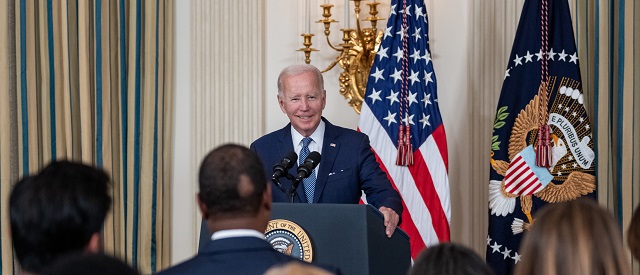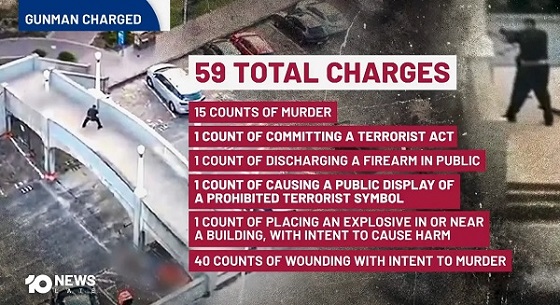International
‘Tripping, Freezing, Forgetting’: Foreign Media Says ‘Distracted’ Biden Is Getting Worse Ahead Of 2024 Election

 From the Daily Caller News Foundation
From the Daily Caller News Foundation
By JAKE SMITH
Several foreign media outlets have published stories in recent months raising concern about President Joe Biden’s health ahead of the 2024 U.S. presidential election.
Biden and his administration maintain that his health is in stable condition and that he is capable of defeating former President Donald Trump in November. But Biden’s recent performance, remarks during press briefings and on-camera appearances have been called into question by a number of major international media outlets, who point to the increasing concern among U.S. voters about his age and mental status.
“Biden isn’t the man he used to be,” a June editorial story from The Independent, a U.K. newspaper, reads. “A failure to take the mounting evidence seriously risks not only a collapse of trust in the White House that will affect future presidents but the specter of real crises during a second Biden term.”
“[Biden has an] inability to function well,” a news story published on Monday by the Hindustan Times, an Indian outlet, reads. “He has come under the spotlight several times for his gaffes, mixing up names of people, and struggling to recall simple words,” reads a separate piece from March.
Biden and his campaign team have downplayed age and health concerns, sometimes leaning into his age as a positive given his decades of political experience. Regardless, Biden’s fitness has remained an issue among swaths of voters; a New York Times/Siena poll conducted in March found that over 70% of voters believed that Biden’s age makes him “ineffective” or incapable of handling the duties of the Oval Office.
“Biden’s main opposition has come from anxiety over his age and health,” a news story in the Chinese-state media outlet Global Times from March reads.
International media outlets especially covered concerns surrounding Biden after Department of Justice Special Counsel Robert Hur released a report in February regarding Biden’s possible mishandling of classified documents. The report recommended not pursuing charges against Biden because he presented himself as a “well-meaning, elderly man with a poor memory” and a jury would likely find him not guilty.
Biden held a press conference the same day the report was released and criticized Hur’s report, but made a series of slip-ups during remarks and shouted at reporters, which some media outlets claimed highlighted Hur’s findings.
“The events underscore the unenviable challenge facing Biden’s aides, who know every verbal slip can exacerbate the biggest liability the president faces — voters worrying he’s not up to the task,” a editorial story from The Japan Times in February reads, claiming that the Biden campaign is “attempting to make it to November free of major gaffes.”
“The numerous references in the report to Joe Biden’s failing memory… give unprecedented force to questions about his physical and mental capacity to stand again,” a news story from French outlet Le Monde wrote about the Hur report. “The worrying episodes are increasing.”
Biden’s behavior was called into question by a number of foreign media outlets at the Group of Seven G7 summit on Friday, in which he stood alongside the leaders of the other G7 nations for a photograph before appearing to wander off and be brought back to the group by Italian Prime Minister Giorgia Meloni.
“Joe Biden’s ‘unusual behavior’ at the G7 leaves leaders ‘alarmed’ and ‘bemused,’” a Monday news headline from Sky News Australia reads.
“The video was widely circulated on social media and sparked debate, with some questioning Biden’s ability to serve another term,” a news story from India Today on Friday reads, claiming that Biden has appeared “dazed” in recent public appearances.
A Pew Global Research survey published on June 11 found that international confidence in Biden’s ability to conduct foreign policy is falling; adults surveyed in 14 nations including Israel, Japan, the U.K. and Australia said their confidence in Biden had “dropped significantly” since 2023. Less than half of respondents in dozens of countries surveyed said that Biden is properly handling the global conflicts of the Russia-Ukraine and Israel-Hamas wars.
The large survey was conducted with thousands of respondents across dozens of countries. The typical margin of error for each country’s survey was between 0% and 5%.
Biden’s mental and physical fitness has been the subject of constant attacks by Trump and his campaign team ahead of the elections in November. The two are expected to face off on the debate stage in Atlanta, Georgia, on June 27.
“Amid the urgent issues for discussion in the first debate between the candidates in the forthcoming US presidential election, age is being weaponized by both contenders,” a Telegraph editorial story on Sunday reads. “But Biden, perhaps distracted by Presidential duties… is late to the party when it comes to throwing shade on a person for being old. His apparent lapses – tripping, freezing, forgetting people’s names, and aimless wandering – most recently at last week’s G7 meeting in Italy – have been gleefully exploited by his opponents.”
The White House did not immediately respond to a request for comment.
(Featured Image Media Credit: Official White House Photo by Cameron Smith)
International
Australian PM booed at Bondi vigil as crowd screams “shame!”

Australian Prime Minister Anthony Albanese faced a wave of public anger Sunday when he appeared at a memorial vigil at Bondi Beach honoring the victims of last week’s brutal terrorist attack on a Hanukkah celebration. The Labor leader was met with loud boos, cries of “shame,” and jeers of “you are not welcome” from furious attendees who blame his government for failing to confront a rise in antisemitism.
Albanese, accompanied by his wife and security detail, appeared visibly rattled as shouts of “blood on your hands” rang out while he walked through the crowd. The hostility didn’t let up during the vigil itself—when the prime minister’s name was mentioned by a speaker, fresh boos erupted.
“Shame on You”
“You are NOT welcome”
Bondi, Australia – Australian Prime Minister @AlboMP heckled by mourners of Bondi Chanukah Massacre@theage @theheraldsun @australian @abcnews @SBSNews @cnnbrk @Jerusalem_Post @nytimes @BBCBreaking @9NewsAUS @10NewsAU @7NewsMelbourne pic.twitter.com/C2xusWFDxQ
— Menachem Vorchheimer (@MenachemV) December 21, 2025
Critics are now intensifying their attacks on Albanese’s left-wing administration, accusing it of turning a blind eye to Jewish concerns in the wake of Hamas’ October 7 rampage in Israel. Among them is Israeli Prime Minister Benjamin Netanyahu, who last week publicly condemned Albanese in an interview with Sky News Australia, saying the terrorist violence in Bondi was “preventable” and that his government had ignored clear warnings about a brewing antisemitic threat.
Footage unearthed by Sky News has only added fuel to the fire. In the video, a younger Albanese is seen at a pro-Palestinian rally standing beside signs declaring “Stop the Israeli Slaughter: Free Palestine Now.” During that demonstration, the future prime minister took aim at Israel’s military, aligning himself with anti-Israel activists. Reports also resurfaced showing that Albanese traveled to meet with the late PLO leader Yasser Arafat in 1998—on a trip reportedly funded by the Palestinian Authority.
Despite the growing discontent, Jewish leaders urged the community not to lose hope. David Ossip, president of the New South Wales Jewish Board of Deputies, opened the Bondi vigil by acknowledging the deep pain felt across the country, calling last week’s massacre a turning point. “We have lost our innocence… our nation has been stained,” Ossip said. But he pointed to the message of Hanukkah as a source of strength: “A single act of courage, a single flame of hope, can give us direction and point the path forward.”
That message stood in stark contrast to the political reality facing Albanese, whose approval ratings have been shaken by his perceived indifference and growing ties to far-left factions that demonize Israel. The backlash now confronting him is not just about a vigil—it’s about years of silence, a pattern of political posturing, and a government many feel has abandoned the people it claims to represent.
Crime
The Uncomfortable Demographics of Islamist Bloodshed—and Why “Islamophobia” Deflection Increases the Threat


Addressing realities directly is the only path toward protecting communities, confronting extremism, and preventing further loss of life, Canadian national security expert argues.
After attacks by Islamic extremists, a familiar pattern follows. Debate erupts. Commentary and interviews flood the media. Op-eds, narratives, talking points, and competing interpretations proliferate in the immediate aftermath of bloodshed. The brief interval since the Bondi beach attack is no exception.
Many of these responses condemn the violence and call for solidarity between Muslims and non-Muslims, as well as for broader societal unity. Their core message is commendable, and I support it: extremist violence is horrific, societies must stand united, and communities most commonly targeted by Islamic extremists—Jews, Christians, non-Muslim minorities, and moderate Muslims—deserve to live in safety and be protected.
Yet many of these info-space engagements miss the mark or cater to a narrow audience of wonks. A recurring concern is that, at some point, many of these engagements suggest, infer, or outright insinuate that non-Muslims, or predominantly non-Muslim societies, are somehow expected or obligated to interpret these attacks through an Islamic or Muslim-impact lens. This framing is frequently reinforced by a familiar “not a true Muslim” narrative regarding the perpetrators, alongside warnings about the risks of Islamophobia.
These misaligned expectations collide with a number of uncomfortable but unavoidable truths. Extremist groups such as ISIS, Al-Qaeda, Hamas, Hezbollah, and decentralized attackers with no formal affiliations have repeatedly and explicitly justified their violence through interpretations of Islamic texts and Islamic history. While most Muslims reject these interpretations, it remains equally true that large, dynamic groups of Muslims worldwide do not—and that these groups are well prepared to, and regularly do, use violence to advance their version of Islam.
Islamic extremist movements do not, and did not, emerge in a vacuum. They draw from the broader Islamic context. This fact is observable, persistent, and cannot be wished or washed away, no matter how hard some may try or many may wish otherwise.
Given this reality, it follows that for most non-Muslims—many of whom do not have detailed knowledge of Islam, its internal theological debates, historical divisions, or political evolution—and for a considerable number of Muslims as well, Islamic extremist violence is perceived as connected to Islam as it manifests globally. This perception persists regardless of nuance, disclaimers, or internal distinctions within the faith and among its followers.
THE COST OF DENIAL AND DEFLECTION
Denying or deflecting from these observable connections prevents society from addressing the central issues following an Islamic extremist attack in a Western country: the fatalities and injuries, how the violence is perceived and experienced by surviving victims, how it is experienced and understood by the majority non-Muslim population, how it is interpreted by non-Muslim governments responsible for public safety, and how it is received by allied nations. Worse, refusing to confront these difficult truths—or branding legitimate concerns as Islamophobia—creates a vacuum, one readily filled by extremist voices and adversarial actors eager to poison and pollute the discussion.
Following such attacks, in addition to thinking first of the direct victims, I sympathize with my Muslim family, friends, colleagues, moderate Muslims worldwide, and Muslim victims of Islamic extremism, particularly given that anti-Muslim bigotry is a real problem they face. For Muslim victims of Islamic extremism, that bigotry constitutes a second blow they must endure. Personal sympathy, however, does not translate into an obligation to center Muslim communal concerns when they were not the targets of the attack. Nor does it impose a public obligation or override how societies can, do, or should process and respond to violence directed at them by Islamic extremists.
As it applies to the general public in Western nations, the principle is simple: there should be no expectation that non-Muslims consider Islam, inter-Islamic identity conflicts, internal theological disputes, or the broader impact on the global Muslim community, when responding to attacks carried out by Islamic extremists. That is, unless Muslims were the victims, in which case some consideration is appropriate.
Quite bluntly, non-Muslims are not required to do so and are entitled to reject and push back against any suggestion that they must or should. Pointedly, they are not Muslims, a fact far too many now seem to overlook.
The arguments presented here will be uncomfortable for many and will likely provoke polarizing discussion. Nonetheless, they articulate an important, human-centered position regarding how Islamic extremist attacks in Western nations are commonly interpreted and understood by non-Muslim majority populations.
Non-Muslims are free to give no consideration to Muslim interests at any time, particularly following an Islamic extremist attack against non-Muslims in a non-Muslim country. The sole exception is that governments retain an obligation to ensure the safety and protection of their Muslim citizens, who face real and heightened threats during these periods. This does not suggest that non-Muslims cannot consider Muslim community members; it simply affirms that they are under no obligation to do so.
The impulse for Muslims to distance moderate Muslims and Islam from extremist attacks—such as the targeting of Jews in Australia or foiled Christmas market plots in Poland and Germany—is understandable.
Muslims do so to protect their own interests, the interests of fellow Muslims, and the reputation of Islam itself. Yet this impulse frequently collapses into the “No True Scotsman” fallacy, pointing to peaceful Muslims as the baseline while asserting that the attackers were not “true Muslims.”
Such claims oversimplify the reality of Islam as it manifests globally and fail to address the legitimate political and social consequences that follow Islamic extremist attacks in predominantly non-Muslim Western societies. These deflections frequently produce unintended effects, such as strengthening anti-Muslim extremist sentiments and movements and undermining efforts to diminish them.
The central issue for public discourse after an Islamic extremist attack is not debating whether the perpetrators were “true” or “false” Muslims, nor assessing downstream impacts on Muslim communities—unless they were the targets.
It is a societal effort to understand why radical ideologies continue to emerge from varying—yet often overlapping—interpretations of Islam, how political struggles within the Muslim world contribute to these ideologies, and how non-Muslim-majority Western countries can realistically and effectively confront and mitigate threats related to Islamic extremism before the next attack occurs and more non-Muslim and Muslim lives are lost.
Addressing these realities directly is the only path toward protecting communities, confronting extremism, and preventing further loss of life.
Ian Bradbury, a global security specialist with over 25 years experience, transitioned from Defence and NatSec roles to found Terra Nova Strategic Management (2009) and 1NAEF (2014). A TEDx, UN, NATO, and Parliament speaker, he focuses on terrorism, hybrid warfare, conflict aid, stability operations, and geo-strategy.
The Bureau is a reader-supported publication.
To receive new posts and support my work, consider becoming a free or paid subscriber.
-

 Censorship Industrial Complex2 days ago
Censorship Industrial Complex2 days agoDeath by a thousand clicks – government censorship of Canada’s internet
-

 Daily Caller2 days ago
Daily Caller2 days agoChinese Billionaire Tried To Build US-Born Baby Empire As Overseas Elites Turn To American Surrogates
-

 Digital ID2 days ago
Digital ID2 days agoCanada releases new digital ID app for personal documents despite privacy concerns
-

 Community2 days ago
Community2 days agoCharitable giving on the decline in Canada
-

 Alberta18 hours ago
Alberta18 hours agoAlberta’s huge oil sands reserves dwarf U.S. shale
-

 Alberta2 days ago
Alberta2 days agoSchools should go back to basics to mitigate effects of AI
-

 Bruce Dowbiggin2 days ago
Bruce Dowbiggin2 days agoNFL Ice Bowls Turn Down The Thermostat on Climate Change Hysteria
-

 Alberta21 hours ago
Alberta21 hours agoCanada’s New Green Deal




